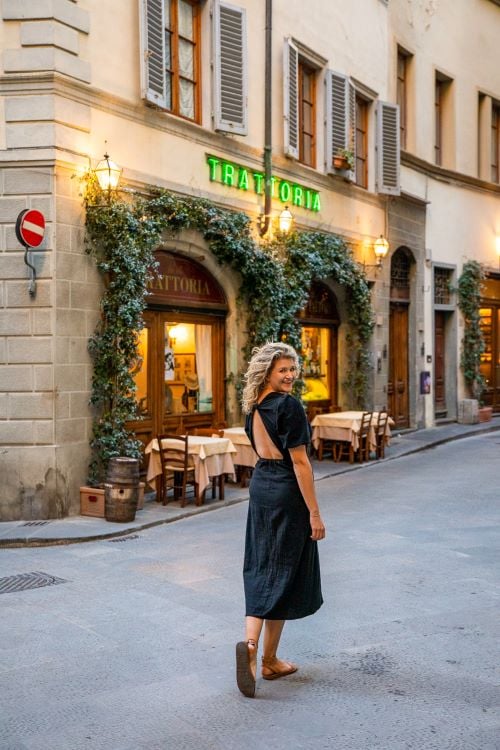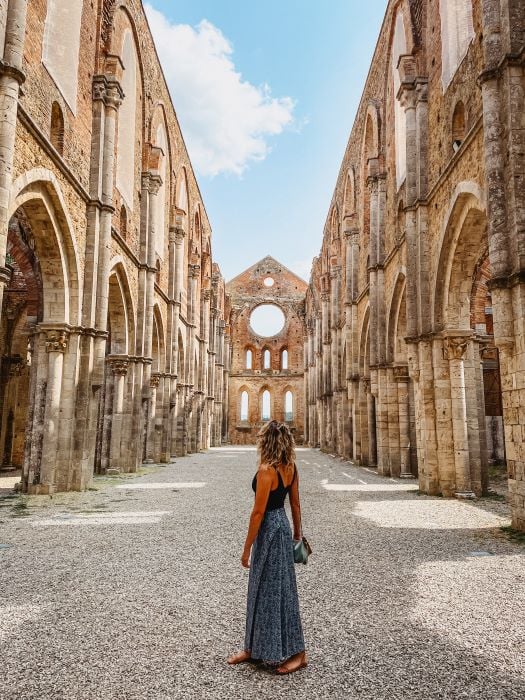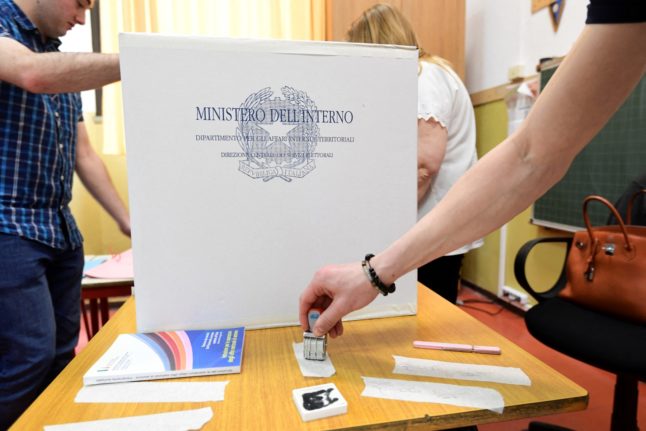Moving to Italy from the States was a no-brainer for Florence-based social media star Kacie Rose Burns. In 2018, aged 24, she dared to book a solo trip to the peninsula and has not looked back since.
“I was a dancer in New York and it was so demanding,” says Kacie, who is now a viral TikTokker with a million followers.
“I lived in a tough city, with a tough career and I was hustling for everything. It was all too grey for me.
“Growing up I had a strong urge to travel to Italy. I don’t know why, I’m only two percent Italian, but I just did.”
Kacie’s initial 10-day solo trip started in Florence, where she met her partner, Dario Nencetti. The pair hit it off immediately and there was an instant attraction that outlasted her 10-day visit: the two were long-distance for a year afterwards. Dario then moved to New York for a year after their long-distance period. Then Covid-19 struck.
“Basically my whole industry shut down during that period and I came to the conclusion I was no longer happy doing dance anymore,” Kacie shares. “Plus Dario’s visa was up.
“And I thought, yeah, let’s give Italy a six-month trial period, and here we are three years later. It sucks you in like that and I know so many people who have had the same experience as me.”

The first six months of Kacie’s time in Italy were not easy. She defines it as one of the hardest periods in her life, due to the many differences in the everyday.
“The biggest shocks are always the first shocks,” she says. “One of them is that I went to a pharmacy to get Dario a birthday card. I asked the pharmacist where I could get a card and granola bar and she looked at me like I had three heads and said “this is a pharmacy”.
“I had no idea where to get a card from because in the States you get lots from the pharmacy. It is the little things from your country and culture that you wouldn’t think about twice, but it’s the little things that are the biggest culture shock.”
The language barrier was another struggle. Although Kacie practised her Italian, she was not prepared for the country’s many different dialects. She recalls a time when she and Dario were in their apartment and he asked her for a Coca-Cola from the fridge.
“In Tuscan dialect, the letter c is removed,” she continues, before chuckling: “I thought he was calling me a rude name.”
READ ALSO:
- ‘Five ways a decade of living in Italy has changed me’
- Ten positives to focus on if you move to Italy from the US
As the months went on, Kacie felt her mindset changing to fit in with a slower pace of life, which she initially said made it harder for her to settle more so than any pharmacy or language barrier could have done.
“Besides the food, I have to say the thing I hated the most at the start is now the thing I love the most about Italy,” she says. “Italians are more embracing of life, they take hold of it. It is not to be taken for granted.

“Americans live to work and I used to thrive off chaos. Italians do way less so. They know how to balance. Having a full life means incorporating rest and coming from a culture that demonises rest, it was hard to grasp at first but now it’s my favourite thing.”
She sums up the lust-for-life attitude she finds more apparent in Italy than in her home country through something her Neapolitan friend said to her.
“One day they turned to me and said ‘Kacie, we live next to a volcano that destroyed a city. We have to live life always’ and it just stuck,” she adds.
Shortly after in 2022, Kacie set up her own tour company, which she says is “the most rewarding” thing she has ever done.
“I can see the beauty through their eyes and it is so special,” she says. “We live in a gorgeous country and we are a little spoiled. It’s not bad at all.”
She details her trials and tribulations and the differences between the two countries she calls home in her upcoming book, You Deserve Good Gelato.
“It’s been a long time coming and I’m so excited,” she says. “More often than not we are more capable than we think we are and it’s a message I wish I had known when I was younger.
“If one person reads this and feels empowered I would be so happy. There are embarrassing mistakes, sad moments, cringey failures and happy moments. Failing is how we learn how to do life. I’ve failed a lot and it’s ok and normal.”
This book has been a year in the making and a few chapters explore adjusting to new countries. When asked what advice she would give Americans looking to make the leap to Italy, she swiftly responds: “Prepare yourselves for Italian bureaucracy.”
READ ALSO: 15 must-have apps to make your life in Italy easier in 2024
“You need time and patience,” she adds. “The biggest piece of advice is it’s not always going to be easy but it will be worth it. My first six months were tough as I had to adjust so much and I was lucky to have a support network in place.
“I have so much respect for people who have no support network in place and moved here alone. That takes guts.
“I guess be prepared for the first six months but know it’ll get easier.”
You Deserve Good Gelato is available to preorder on Amazon and comes out worldwide on May 28th.




 Please whitelist us to continue reading.
Please whitelist us to continue reading.
I’ve followed Kacie almost from the beginning of her journey and it’s been amazing seeing her thrive. Wishing her the best of luck with the book.